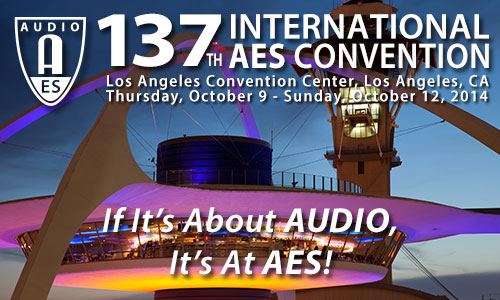
AES Los Angeles 2014
Paper Session P7
Friday, October 10, 9:00 am — 11:30 am (Room 309)
Paper Session: P7 - Cinema Sound, Recording and Production
Chair:
Scott Levine, Skywalker Sound - Marin County, CA, USA; The Centre for Interdisciplinary Research in Music Media and Technology - Montreal, Quebec, Canada
P7-1 Particle Systems for Creating Highly Complex Sound Design Content—Nuno Fonseca, ESTG/CIIC, Polytechnic Institute of Leiria - Leiria, Portugal
Even with current audio technology, many sound design tasks present practical constraints in terms of layering sounds, creating sound variations, fragmenting sound, and ensuring space distribution especially when trying to handle highly complex scenarios with a significant number of audio sources. This paper presents the use of particles systems and virtual microphones, as a new approach to sound design, allowing the mixing of thousands or even millions of sound sources, without requiring laborious work and providing a true coherence between sound and space, with support for several surround formats, Ambisonics, Binaural, and even partial Dolby Atmos support. By controlling a particle system, instead of individual sound sources, a high number of sounds can be easily spread over a virtual space. By adding movement or random audio effects, even complex scenarios can be created.
Convention Paper 9132 (Purchase now)
P7-2 Stage Metaphor Mixing on a Multi-Touch Tablet Device—Steven Gelineck, Aalborg University Copenhagen - Copenhagen, Denmark; Dannie Korsgaard, Aalborg University - Copenhagen, Denmark
This paper presents a tablet based interface (the Music Mixing Surface) for supporting a more natural user experience while mixing music. It focuses on the so-called stage metaphor control scheme where audio channels are represented by virtual widgets on a virtual stage. Through previous research the interface has been developed iteratively with several evaluation sessions with professional users on different platforms. The iteration presented here has been developed especially for the mobile tablet platform and explores this format for music mixing both in a professional and casual setting. The paper first discusses various contexts in which the tablet platform might be optimal for music mixing. It then describes the overall design of the mixing interface (especially focused on the stage metaphor), after which the iOS implementation is briefly described. Finally, the interface is evaluated in a qualitative user study comparing it to two alternative existing tablet solutions. Results are presented and discussed focusing on how the evaluated interfaces invite four different forms of exploration of the mix and on what consequences this has in a mobile mixing context.
Convention Paper 9133 (Purchase now)
P7-3 The Duplex Panner: Comparative Testing and Applications of an Enhanced Stereo Panning Technique for Headphone-Reproduced Commercial Music—Samuel Nacach, New York University - New York, NY, USA
As a result of new technology advances consumers primarily interact with recorded music on-the-go through headphones. Yet, music is primarily mixed using stereo loudspeaker systems consisting of crosstalk signals, which are absent in headphone reproduction. Consequently, the audio engineer's intended sound image collapses with headphones. To solve this, the work presented in this paper examines existing 3D audio techniques—primarily Binaural Audio and Ambiophonics—and enhances them to develop a novel and improved mixing technique, the Duplex Panner, for headphone-reproduced commercial music. Through subjective experiments designed for two groups, the Duplex Panner is compared to conventional Stereo panning to determine what the advantages are, if any.
Convention Paper 9134 (Purchase now)
P7-4 The Role of Acoustic Condition on High Frequency Preference—Richard King, McGill University - Montreal, Quebec, Canada; The Centre for Interdisciplinary Research in Music Media and Technology - Montreal, Quebec, Canada; Brett Leonard, University of Nebraska at Omaha - Omaha, NE; McGill University - Montreal, Quebec, Canada; Stuart Bremner, McGill University - Montreal, Quebec, Canada; The Centre for Interdiciplinary Research in music Media & Technology - Montreal, QC, Canada; Grzegorz Sikora, Bang & Olufsen Deutschland GmbH - Pullach, Germany
Subjective preference for high frequency content in music program has shown a wide variance in baseline testing involving expert listeners. The same well-trained subjects are retested for consistency in setting a high frequency shelf equalizer to a preferred level under varying acoustic conditions. Double-blind testing indicates that lateral energy significantly influences high frequency preference. Furthermore, subject polling indicates that blind preference of acoustic condition is inversely related to optimal consistency when performing high frequency equalization tasks.
Convention Paper 9135 (Purchase now)
P7-5 Listener Preferences for Analog and Digital Summing Based on Music Genre—Eric Tarr, Belmont University - Nashville, TN, USA; Jane Howard, Belmont University - Nashville, TN, USA; Benjamin Stager, Belmont University - Nashville, TN, USA
The summation of multiple audio signals can be accomplished using digital or analog technologies. Digital summing and analog summing are not identical processes and, therefore, produce different results. In this study digital summing and analog summing were performed separately on the audio signals of three different recordings of music. These recordings represented three genres of music: classical, pop/country, and heavy rock. Twenty-one listeners participated in a preference test comparing digital summing to analog summing. Results indicated that listeners preferred one type of summing to the other; this preference was dependent on the genre of music.
Convention Paper 9136 (Purchase now)
